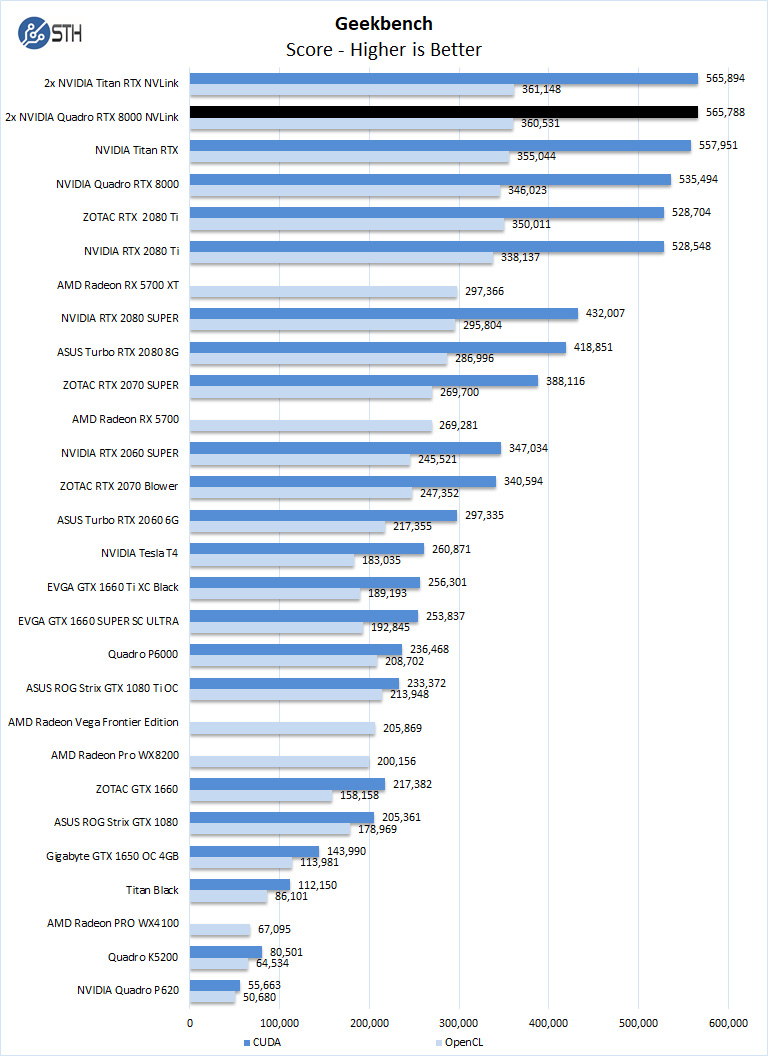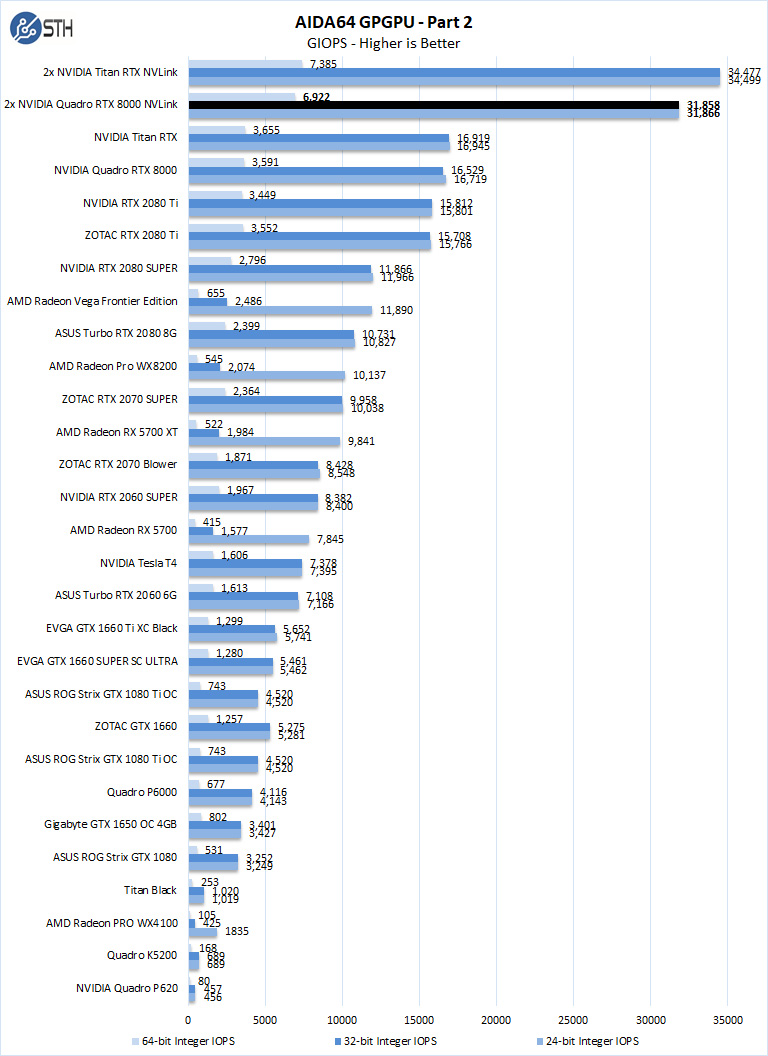NVIDIA Quadro RTX 8000 NVLINK Compute Related Benchmarks
As we saw in our review of the single NVIDIA Quadro RTX 8000 performance is close to a Titan RTX. In NVLINK mode, we will find some benchmarks do not take advantage of two of these GPU’s, the strength of moving to an NVLINK configuration is apparent in Deep Learning and Content Creation applications.
Geekbench 4
Geekbench 4 measures the compute performance of your GPU using image processing to computer vision to number crunching.

Our first compute benchmark, and we see the NVIDIA Quadro RTX 8000 NVLINK achieves results close to the NVIDIA Titan RTX NVLINK. There is a slight difference in numbers that we attest to cooling differences with the dual-fan Titan RTX having an edge here. We will see this difference in other benchmarks also.
LuxMark
LuxMark is an OpenCL benchmark tool based on LuxRender.

Like our Geekbench results, we find a slight difference between the NVIDIA Quadro RTX 8000 and Titan RTX in NVLINK configurations.
AIDA64 GPGPU
These benchmarks are designed to measure GPGPU computing performance via different OpenCL workloads.
- Single-Precision FLOPS: Measures the classic MAD (Multiply-Addition) performance of the GPU, otherwise known as FLOPS (Floating-Point Operations Per Second), with single-precision (32-bit, “float”) floating-point data.
- Double-Precision FLOPS: Measures the classic MAD (Multiply-Addition) performance of the GPU, otherwise known as FLOPS (Floating-Point Operations Per Second), with double-precision (64-bit, “double”) floating-point data.

The next set of benchmarks from AIDA64 are:
- 24-bit Integer IOPS: Measures the classic MAD (Multiply-Addition) performance of the GPU, otherwise known as IOPS (Integer Operations Per Second), with 24-bit integer (“int24”) data. This particular data type defined in OpenCL on the basis that many GPUs are capable of executing int24 operations via their floating-point units.
- 32-bit Integer IOPS: Measures the classic MAD (Multiply-Addition) performance of the GPU, otherwise known as IOPS (Integer Operations Per Second), with 32-bit integer (“int”) data.
- 64-bit Integer IOPS: Measures the classic MAD (Multiply-Addition) performance of the GPU, otherwise known as IOPS (Integer Operations Per Second), with 64-bit integer (“long”) data. Most GPUs do not have dedicated execution resources for 64-bit integer operations, so instead, they emulate the 64-bit integer operations via existing 32-bit integer execution units.

The take away here is the NVIDIA Quadro RTX 8000 NVLINK archives near Titan RTX NVLINK performance.
hashcat64
hashcat64 is a password cracking benchmarks that can run an impressive number of different algorithms. We used the windows version and a simple command of hashcat64 -b. Out of these results, we used five results in the graph. Users who are interested in hashcat can find the download here.

Hashcat can put a heavy load on GPU’s, and here we see the dual-fan graphics cards have the edge in our results.
Let us move on and start our new tests with rendering-related benchmarks.




Why is the Radeon VII not in the comparison, William? It would be competitive in some tests.
Emerth – we do not have one to test and they are discontinued. As a result, it is a low priority. We may look at the Radeon Pro version, but that just started shipping.
Can it run fortnite at 60 fps though?
I would really love to see some testing with this card for VGPUs in VMWare :P
@Jeremy likely it can simulate running Fortnite at 60FPS.
About AIDA64 GPGPU Part1 graph of Page 3, My Titan Black’ Double-Precision FLOPS value is 1842 when “Double precision” is enabled on NVIDIA control panel → Manager 3D settings. Default is disabled! when disabled, the score plummets to 256.7 GFLOPS and it matches the graph value.
It is better to show the better score, their double precision circuit is fully utilized IMO
OctaneRender 4 does not take advantage from quadro or Titan cards, rtx 2080ti result should be comparable to rtx 8000, SLI should just halve the time.
https://render.otoy.com/octanebench/results.php?v=4.00&sort_by=avg&filter=&singleGPU=1
I guess something went wrong.
yamamoto wrote: About AIDA64 GPGPU Part1 graph of Page 3, My Titan Black’ Double-Precision FLOPS value is 1842 when “Double precision” is enabled on NVIDIA control panel.
This is a very important point.
When reading through the review I was about to ignore this card as yet another AI GPU unsuited for doing science. Now your comment has me wondering which other cards treated here suffered a similar methodological problem with double precision arithmetic.
@Eric
Maybe other Kepler GPUs such as GTX Titan or Quadro K6000 are affected
I have a Titan V, there is no “Double Precision” menu item on NVIDIA Control Panel on this GPU and its AIDA64 Double-Precision score is 6283 GFLOPS. It is cost effective solution for some scientific calculation IMO.
Can this gpu beat the titan v in case of gaming and editing .